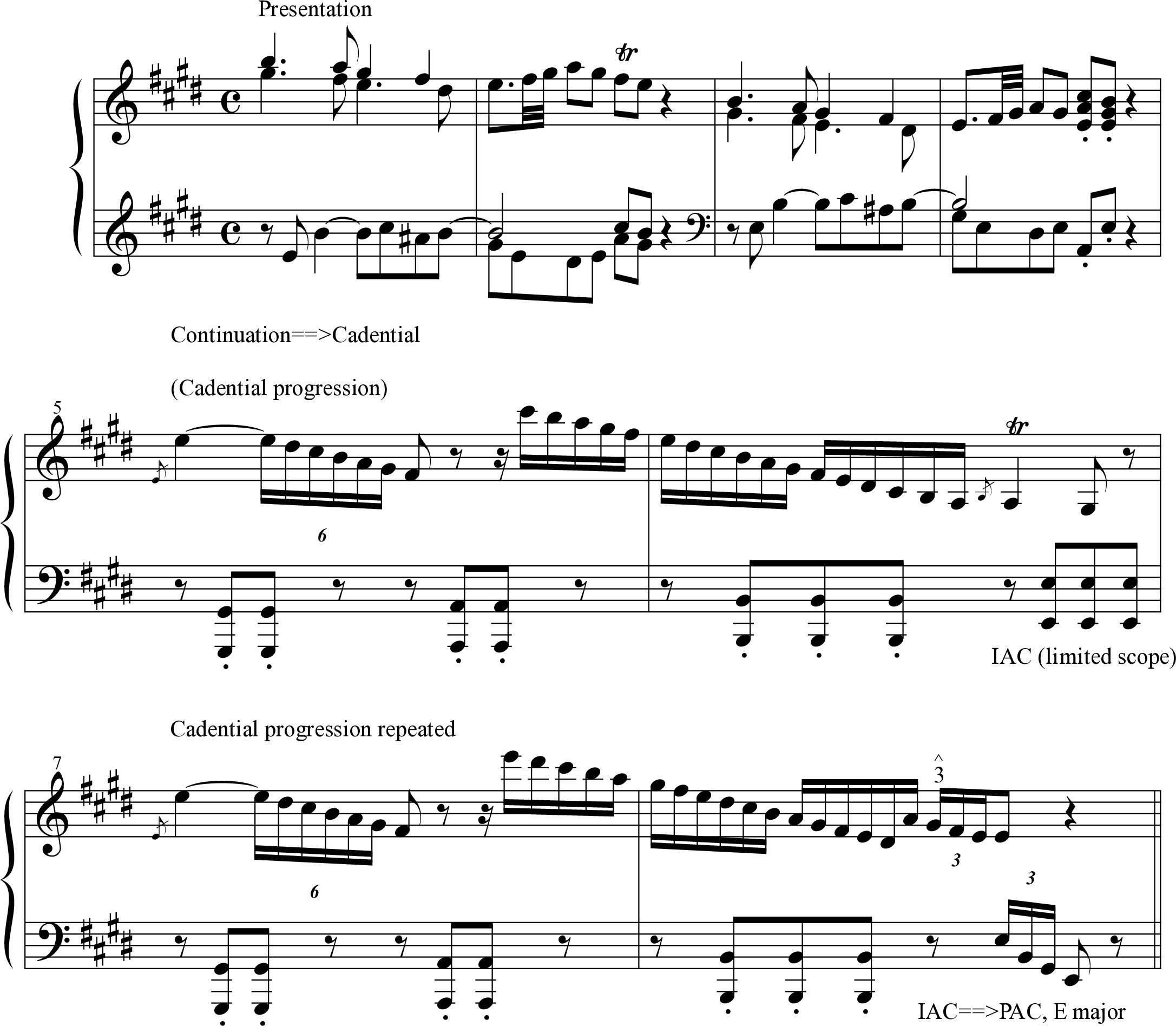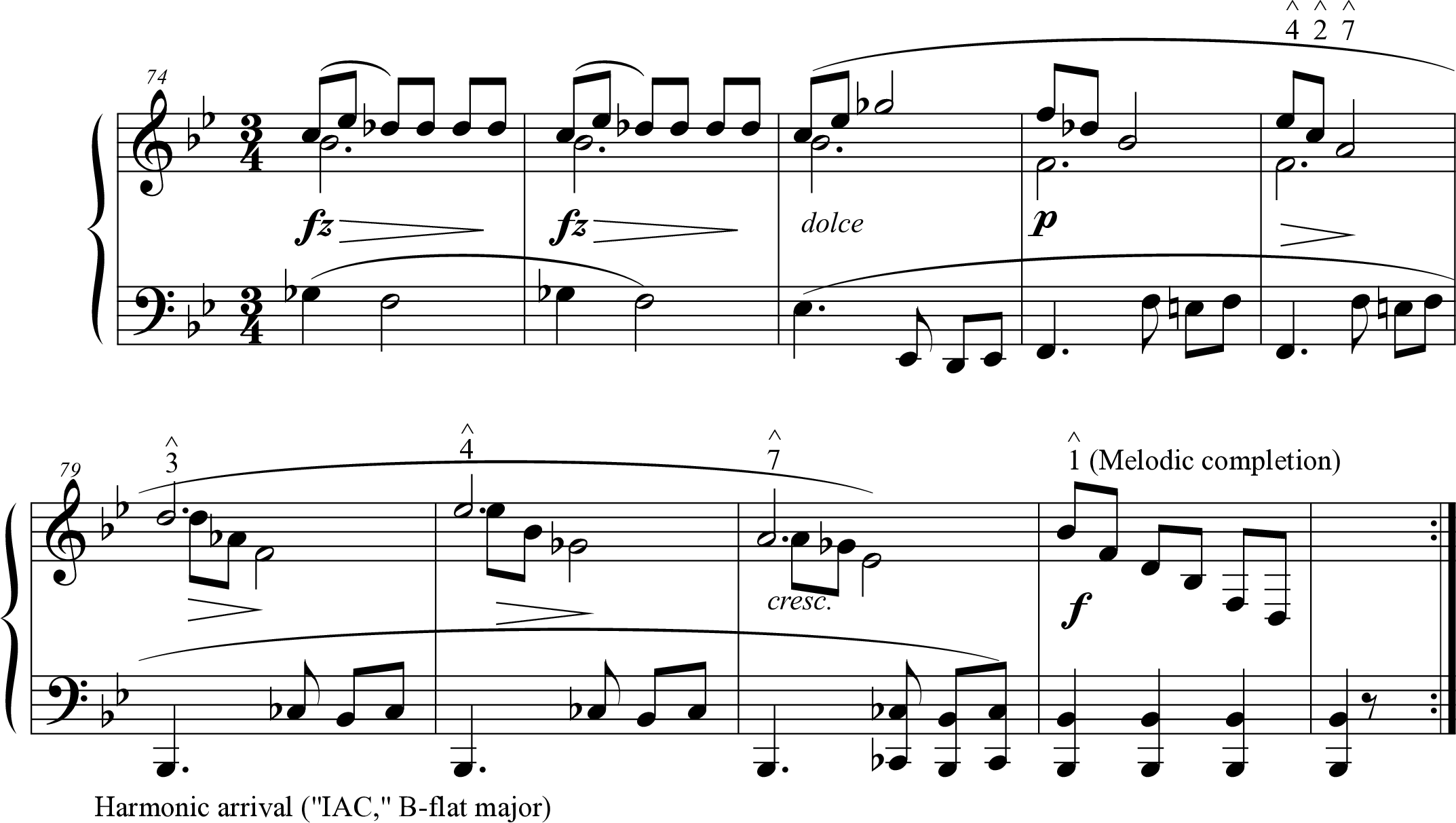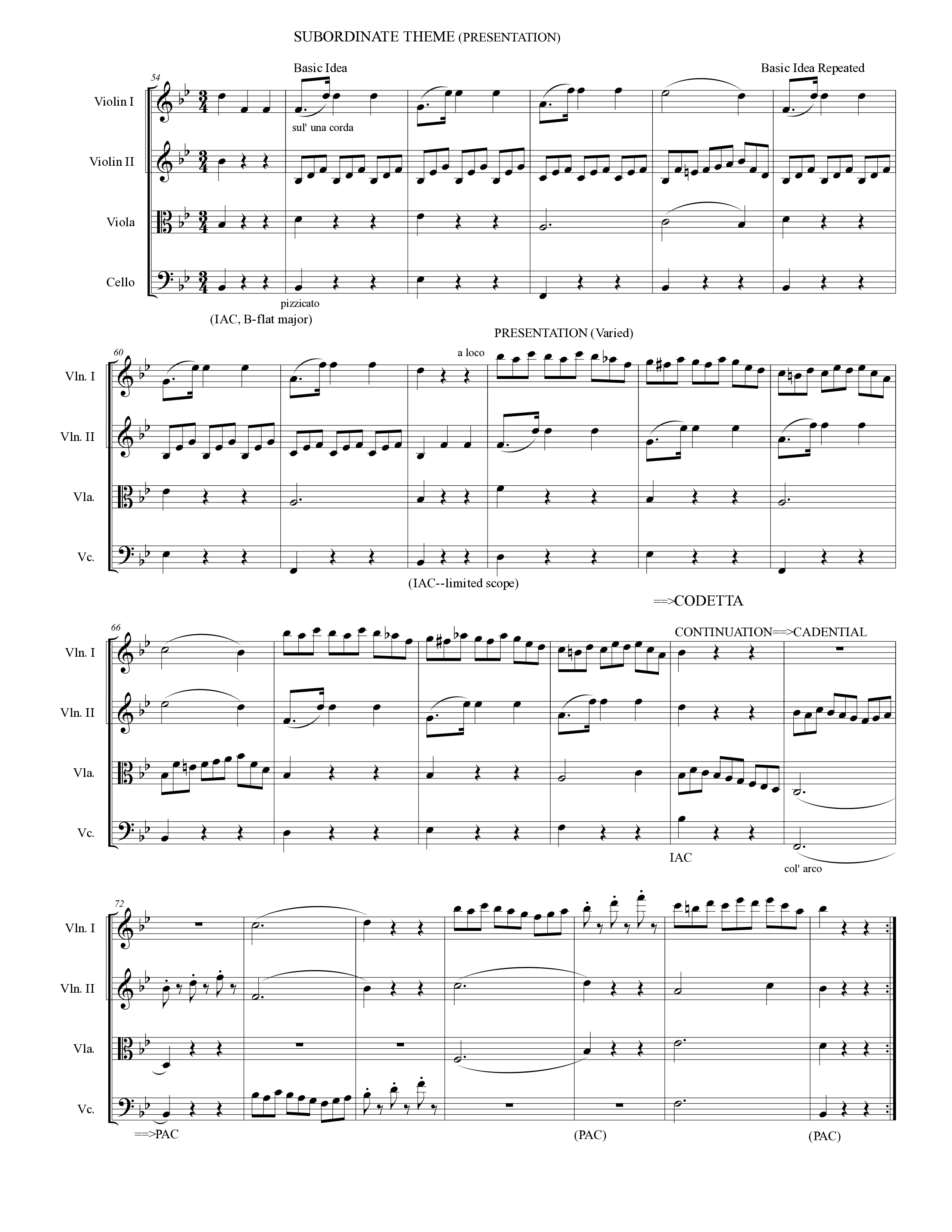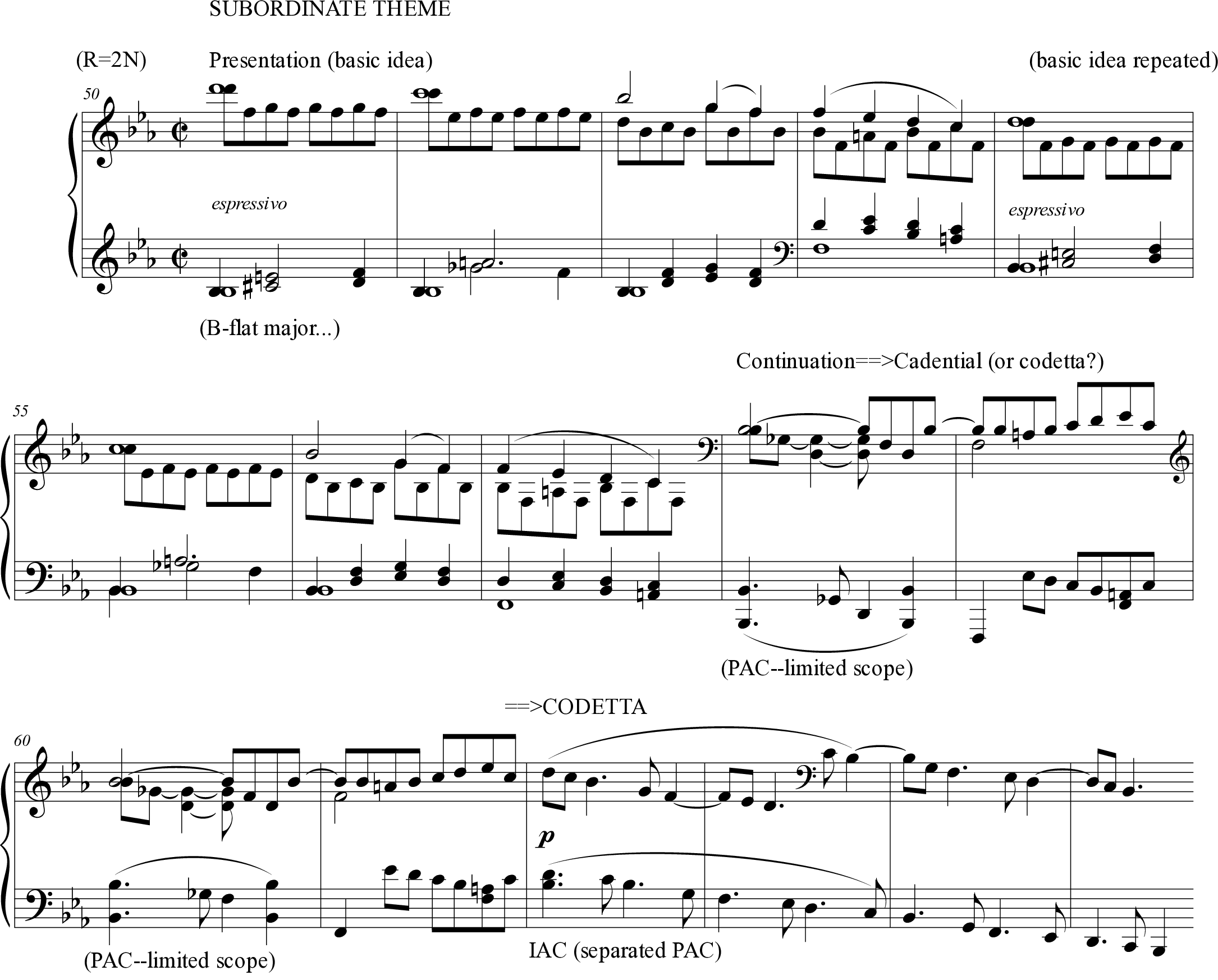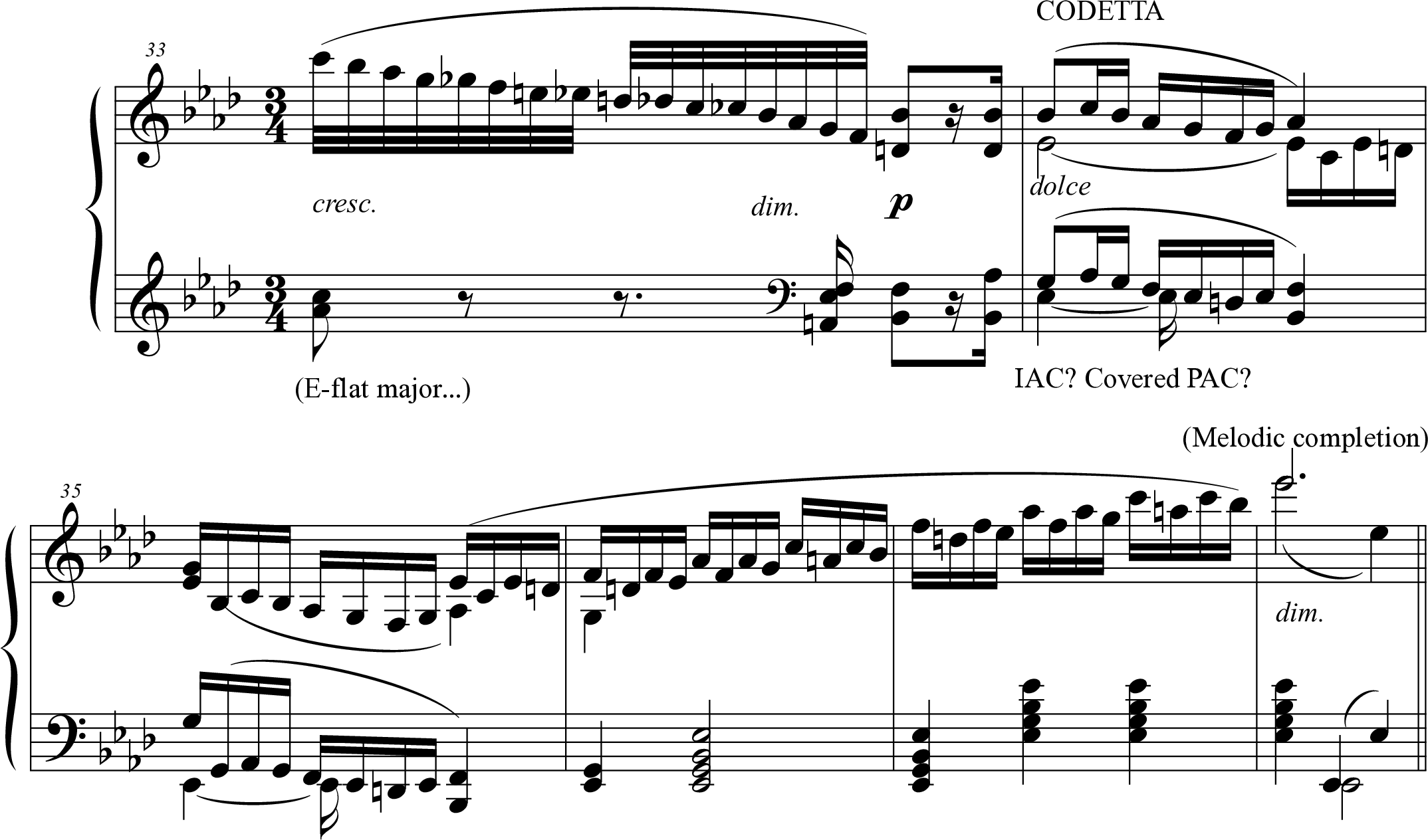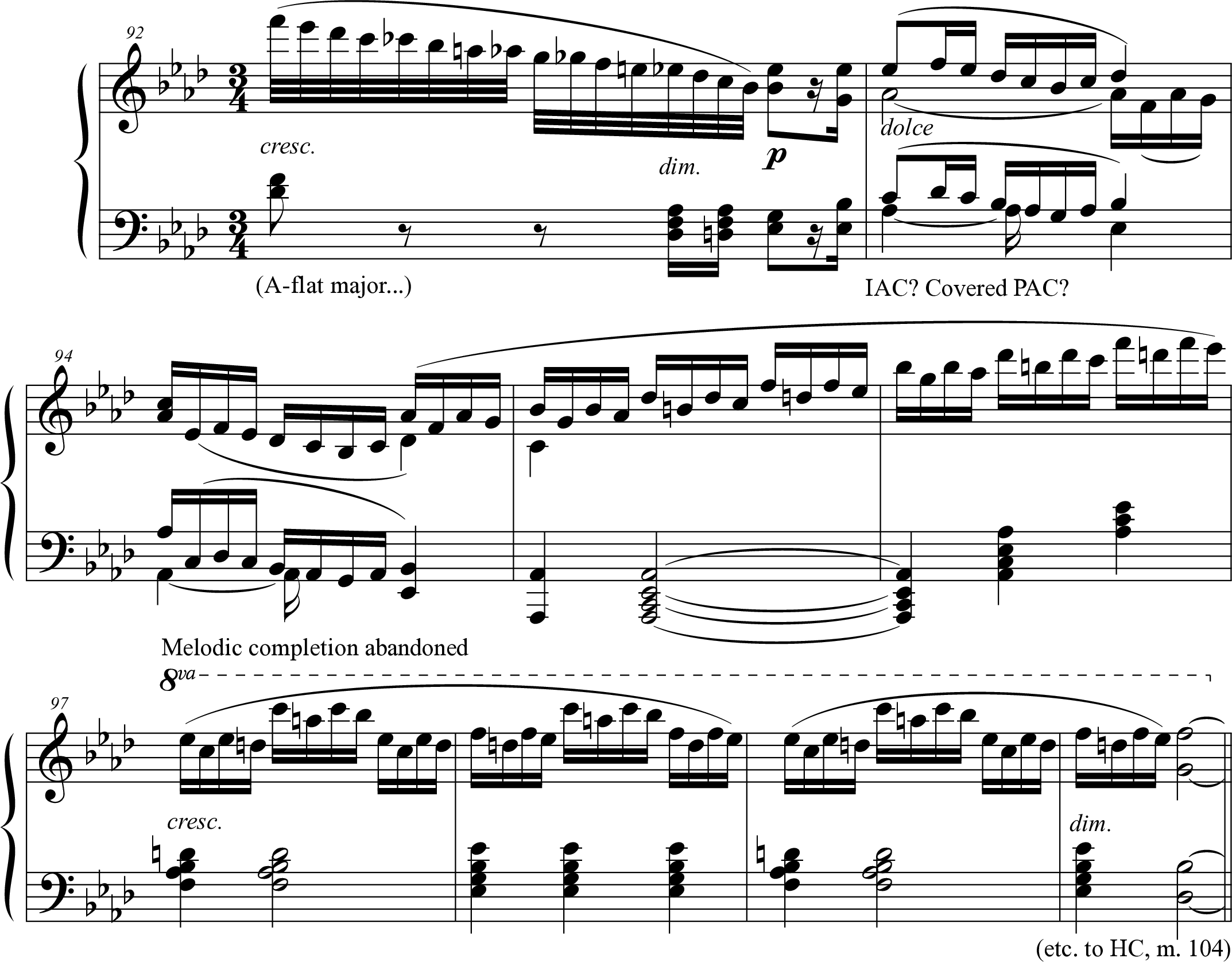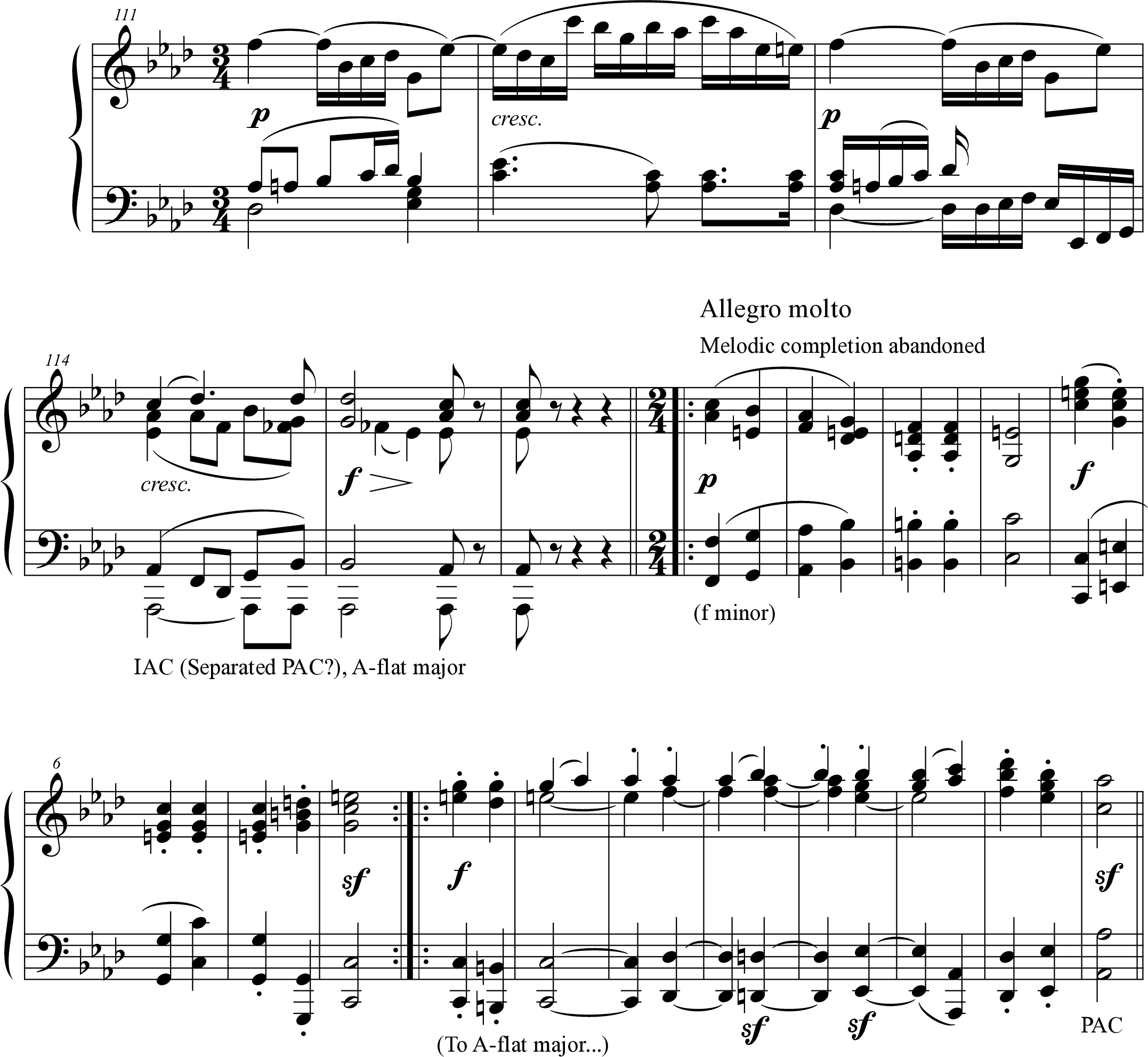Introduction
A passage from Ludwig van Beethoven’s Hammerklavier Sonata, op. 106, first movement (marking the end of Subordinate Theme I) illustrates an intriguing quandary as to the nature of formal closure in the Classical era (Example 1):
Contrary to his usual practice, Beethoven uses the melodically inconclusive IAC in a formal location where the full closure of a PAC was normally expected. Certainly, recent authors on sonata form (William E. Caplin, L. Poundie Burstein, James Hepokoski and Warren Darcy) view an IAC at a sonata exposition’s final cadence to be an exceedingly rare (albeit not completely non-existent) option in the Classical period. Cf. Caplin (1998, 97); Burstein (2020, 38); Hepokoski and Darcy (2006, 169).
The following study explores this rare formal decision: Classical-era subordinate themes that end with what syntactically appears to be an IAC. When such cadences occur at formal junctures where full closure is paramount, the composer may defer melodic closure until a later beat, which Mark Richards (2010, 35–39) terms a “separated cadence.” Richards (2012, 218–219), like the authors cited above, permits the IAC as the subordinate theme’s concluding cadence as an infrequent alternative to the PAC. As an extension of Richards’ concept, this study examines this technique in selected works by Muzio Clementi, Joseph Haydn, and Ludwig van Beethoven, demonstrating how terminal gestures at the end of a sonata exposition in which an apparent IAC substitutes for an expected PAC can nonetheless ultimately create full closure. In such cases, rather than ending forthrightly with the moment of harmonic completion (the goal tone in the bass that signals the apparent IAC), the section achieves its goal in a later measure when the melodic line reaches , thus creating an IAC→PAC cadential complex, following Janet Schmalfeldt’s concept of “becoming” (2011). Subordinate themes that end in this manner may fuse with the ensuing codetta (closing section) into a single formal unit, which, pace Schmalfeldt, will be described in this study as subordinate theme→codetta. The arrow signifies one formal unit “becoming” another: see Schmalfeldt (2011, 38).
As a counter-example, the final section of this study will examine a late work by Beethoven, his Sonata in A♭ major, op. 110 (1821), to illustrate a more flexible aesthetic of cadential finality. In this work’s opening movement, an IAC not only marks the end of the exposition, but (uniquely for Beethoven) also returns in the coda as the movement’s final musical event. At this stage, the IAC takes on the status of a terminal cadence, despite its melodic inconclusiveness. Such an ending creates a poetic blend of finality and open-endedness that would soon thereafter appeal to the sensibilities of the Romantic generation of composers.
The IAC and Formal Closure: A Historical Viewpoint
The renewed interest in a Formenlehre approach to musical structure in recent decades, initiated by Caplin’s Classical Form, and further pursued by Hepokoski and Darcy’s Elements of Sonata Theory, has elicited a rethinking of many fundamentals of syntax. Since closure is a vital component of formal articulation, the concept of cadence has undergone a thorough reexamination. Consequently, the proliferation of cadence types that amassed during the nineteenth and twentieth centuries has been called into question by various authors. Burstein (2015) remarks upon the “analytical fiction” of the half cadence, while Caplin’s theory of formal functions denies many hallowed cadence types from having formal significance, such as the plagal cadence, considered post-cadential in Caplin (1998, 43–45), and the deceptive cadence, described in Caplin (1998, 29) as a specific category of cadential evasion. On a related note, Robert Gjerdingen’s (2017) schema theory discusses many historic cadence types from the Renaissance and Baroque eras, along with their use and adaptation by mid-eighteenth-century composers. Under some circumstances, the imperfect authentic cadence could arguably be included in this rethinking as well. MacKay (2017, 1) proposes such an exclusion on historic grounds.
The IAC, a closure type whose status was in flux during the eighteenth century, provides an intriguing set of challenges in the analysis of mid-to-late-eighteenth-century music. In the Classical period, as explored in the New Formenlehre of Caplin and others, Nicholas Marston (2001, 143), in a review of Caplin’s Classical Form, was the first author to use this term, later taken up by multiple authors in reference to the revival of Formenlehre by Caplin, Schmalfeldt, and others. the IAC typically serves as a middle event rather than a concluding one: its combination (per Caplin 1998, 27) of full harmonic closure (V-I in root position) and melodic open-endedness (concluding on or ) makes it highly appropriate for such an intermediate role. Earlier authors, e.g., Green (1979, 13), have a broader definition, allowing V6–I and viio6–I progressions as IACs. This article follows Caplin’s stricter criteria. The history of the IAC partially explains its flexible use: in the Renaissance-Baroque understanding of cadence, such a close was non-cadential, since one of the structural voices did not terminate on the local melodic goal. This type of closure was categorized as one of many means of “evading the cadence” (“fuggir la cadenza,” per Gioseffo Zarlino), from the 1500s until the mid-eighteenth century. Cf. Gjerdingen (2007, 139–41). This earlier theoretical conception of cadence was still fundamental to the musical training of Joseph Haydn (by Georg Reutter the Younger) and Wolfgang Amadeus Mozart (by his father Leopold), despite a gradual shift in musical practice during the pre-Classical era. As noted in Hepokoski (2021, 10–11), shifting historical concepts of cadence can impact our conception of cadential strength and classification.
Despite this historic precedent, the use of the IAC at a place where full closure would be pro forma is a plausible (if rare) musical option from about 1750 onward—Burstein (2020, 38) illustrates such a cadence in the final measure of Georg Benda’s Keyboard Sonata no. 1 in B♭ major, first movement, written in 1757. As such, the cadential potential of the IAC is considerably more varied and nuanced than is generally acknowledged. Xieyi (Abby) Zhang (2022, 191) discusses, among other possibilities, the standard IAC, which effects convincing (if not melodically complete) closure at a phrase ending; the deceptive IAC that necessitates a “one more time” reprise of the phrase Defined in Schmalfeldt 1992, 2. ; and the covered perfect authentic cadence (PAC), where the composer overwrites the melodic ending on the local tonic by superimposing a less conclusive scale degree above it. After illustrating each of these possibilities, Zhang (2022, 197) acknowledges that the differences between these IAC categories “are not always as clearly drawn,” with a resultant impact on the listener's perception of such cadences’ strength or degree of finality. The “separated cadence” described in Richards (2010, 35-39) is an added musical wrinkle, in which a seeming IAC on the musical surface can serve retrospectively as full closure (i.e., as a de facto PAC) once its melodic process is complete. We will now explore this concept in depth.
Melodic Deferral and Cadential Finality
Though a forthright musical articulation of formal boundaries with cadences typifies the Classical era, not all Classical cadences rely upon an exact coincidence of harmonic and melodic completion. With the half cadence (HC) especially, melodic continuation often persists long beyond the actual point of harmonic arrival, functioning as filler material to add suspense to the cadential moment, as discussed in Burstein (2015, 86–90). Classical composers often proceed similarly with the IAC, creating a brief feeling of openness, later made right by a melodic turn to the local tonic to achieve closure.
The concept of melodic deferral at authentic cadences can be illustrated with a common Classical gesture: the cadence with appoggiatura, featuring a “sighing motif” consisting of – or –, over a V–I harmonic progression. A vestigial Galant device, this artful withholding of the tonic in the melody until an unaccented beat is common in the Classical period. As Caplin (2004, 77) describes this well-known device: “frequently, the sense of melodic closure for the thematic unit occurs somewhat after the final cadential harmony arrives, usually as a result of suspension resolutions or some further arpeggiation of the tones of the final harmony.” Example 2 presents a representative use of this device from Beethoven’s Sonata in E♭ major, op. 7, second movement. Here, the melodic delay cleverly integrates the cadence into the theme’s motivic content: the appoggiatura that delays the melodic onset of the tonic arises inevitably from the two-note sighing motifs earlier in the phrase. Such phrase-ending moments, where the composer delays melodic completion at a potential cadence contains within it the seeds of Richards’ “separated cadence,” acknowledging the complete finality of such a closure type, despite its melodic deferral.
Though Caplin seems to equate melodic delaying through suspensions and melodic delaying through tonic arpeggiation, the latter technique is more provocative analytically, creating a cadential quandary that warrants further consideration. According to Heinrich Christoph Koch’s concept of Überhang (overhang), the note of the tonic chord that coincides with the phrase’s harmonic completion is the primary goal tone, and the subsequent melodic descent is decorative (see Koch 1983 [1793], 22). When this device occurs at a thematic ending, it subtly undercuts the finality of the cadential effect, opening two possible analytic perspectives: an IAC, following Koch, in which the melodic completion to the tonic serves a decorative purpose; or a separated PAC, after Richards, where the late-arriving tonic note in the melody links with the prior harmonic completion.
The main theme of Haydn’s Sonata in E major, Hob. XVI: 31, first movement, aptly illustrates this melodic device, and the cadential ambiguity that results from it (Example 3. Following a four-measure presentation phrase, mm. 5–8 form a continuation→cadential phrase, comprising a two-measure cadential segment stated twice. The first cadential statement ends in m. 6 with an apparent IAC (the melody terminates on ), but no cadential status is inferred, since this progression lies at the midpoint of the phrase. Such progressions, which feature the harmonic content of a cadential progression in the “wrong” form-functional location, exemplify cadences “of limited scope” (Caplin 2004, 86–89). This particular progression exemplifies the “deceptive IAC” discussed in Zhang (2022, 194-196), whose melodic incompletion leads to a “one more time” repeat of the cadential module, similar to (harmonically) deceptive cadences such as V–vi. This technique often occurs at the phrase level as well; e.g., the main theme of Beethoven’s Sonata in C major, Opus 2 no. 3, featuring a second phrase that terminates with an IAC, followed by a “one more time” reprise that ends conclusively with a PAC.
The immediate repetition of this two-measure phrase member likewise reaches as its melodic goal (m. 8, beat 3), thus at first seeming to form (once again) an IAC. Haydn quickly descends to the tonic, however, to create full melodic closure, if belatedly. This brief Überhang exemplifies Richards’ separated PAC, thereby accounting for the misalignment of harmonic and melodic closure. Invoking Schmalfeldt’s “becoming,” such a cadence (as noted above) will be labeled IAC→PAC to indicate retrospectively its status as a cadence that is fully conclusive, both melodically and harmonically.
Longer-Range Melodic Deferral: The "Separated Cadence" and the Subordinate Theme→Codetta Cadential Complex
The foregoing passages illustrate that harmonic and melodic completion need not coincide exactly to create or approximate the full harmonic and melodic closure of a PAC at the phrase level. As a longer-range manifestation of this same phenomenon, an IAC at the end of a theme may subsequently reach full closure through the addition of a phrase member (a contrasting idea or cadential extension), a complete phrase, or a new formal section that eventually turns melodically to the tonic. As Richards (2010, 39) notes, cadences embellished with appoggiaturas, in which the delay in melodic completion is brief, “serve as important models for more complex situations in their use of a cadential arrival that is spread across more than a single beat.” Clementi’s Sonata in G Minor, op. 34, no. 2, first movement (ca. 1795), will serve as a preliminary illustration of this technique.
The first movement, complete with slow introduction, is symphonic in scope and execution. The stormy exposition moves from the home tonality to the expected mediant tonality, B♭ major, tinged though with extensive modal mixture as the section nears its conclusion. The goal is a V7–I cadential motion in this key in m. 79, which serves as the EEC, or essential expositional closure, according to the analysis by Hepokoski and Darcy (2006, 62) of the sonata’s first half (see Example 4a). As part of the cadential gesture, m. 78 features an arpeggiated dominant seventh in the melody (––), which highlights a melodic tritone span that requires resolution. In m. 79, Clementi resolves , the upper note of the tritone, to , creating a melodically open-ended effect on a tonic chord. (Clementi almost immediately adds an A♭ to this harmony, transforming the final tonic chord into a secondary dominant, but the fleeting effect of an IAC remains active in the listener’s ear.)
Following the bass arrival of m. 79, the melody continues to spin out over a tonic pedal in a brief codetta. In this passage, Clementi restates the – tritone span in the melody, but this time resolves the lower note, , upward to the tonic to provide full melodic closure. Clementi’s decision to resolve the subdominant scale degree first (rather than resolving the – motion) was what created the subordinate theme’s inconclusive melodic closure. The final four measures, far from being unambiguously post-cadential (as would be the norm), act as an extension of the subordinate theme: this concluding passage accounts for the melodic line’s remaining active tone, tying up the exposition’s final tonal loose end. In Sonata Theory terms, the “IAC-effect” of m. 79 weakens the EEC; thus, the exposition’s “C-space” takes on the responsibility of completing the cadential process (Hepokoski and Darcy 2006, 169).
The voice-leading situation in these measures strongly resembles the PAC with appoggiatura (or other melodic embellishment) discussed above. Such authentic cadences likewise involve an artful melodic delaying of the tonic: they differ only in the span of time between harmonic closure and melodic completion. Consider as well that mm. 79–83, in a triple meter work played at allegro tempo, would span barely five seconds in performance, allowing the listener to link the bass arrival of m. 79 with the melodic arrival of m. 82. Further, this brief span of time is not substantially longer than the length of melodic delay that an appoggiatura or Überhang would create at a slow tempo. To be certain, the three-measure gap between harmonic and melodic completion does not prevent this passage from projecting a sense of full harmonic and melodic closure, though Clementi’s artful delaying of the melody’s goal tone creates a musically nuanced conclusion rather than an unambiguously forthright one.
Clementi seemed to recognize the deliberate ambiguity of this cadential effect, based on how he reworked this passage later in the movement: the parallel passage in the recapitulation (mm. 233–236) is considerably less elusive, with full melodic and harmonic closure occurring simultaneously, rather than being separated by multiple measures as they had been in the exposition (see Example 4b).
In this passage, the subordinate theme’s final phrase concludes with a PAC, though with registral shift. Modeled on a prior phrase ending (m. 218), the tonic note arrives at a fortissimo dynamic in m. 236, followed by an extended scalar passage in octaves. Clementi thereby eliminates the temporal disconnect between melodic and harmonic completion for a more conclusive cadential effect. (Granted, the registral shift suggests an elision with the following phrase rather than an unambiguous conclusion similar to m. 64ff.) Clementi drives home this point later in the movement as well: a reprise of the subordinate theme’s second half leads to yet another PAC in m. 256 (see Example 4c). This time, Clementi resolves the melody to the tonic in the same octave, after which four measures, unfolding over a tonic pedal, lead to a brief codetta.
Thus, as the movement progresses, Clementi provides an increase in cadential clarity, moving from a separated cadence in the exposition, to an elided PAC late in the recapitulation, to a forthright, full close on a PAC in its final measures. This clarification sheds new light on the nature of the cadence that concluded the subordinate theme in m. 79: despite the melodic delay in its initial presentation, Clementi presents this cadence as being formally final, if gesturally incomplete; thus, not as an IAC but as a PAC from which the composer has artfully deviated, for rhetorical effect.
The melodic delaying of a cadential goal at the end of a subordinate theme also appears, if rarely, in the sonata-form movements of Haydn and Beethoven. If one agrees with Caplin’s assertion (1998, 97) that a subordinate theme must end with a PAC, thus creating full harmonic and melodic closure, such anomalous closes must be reconciled analytically in some way. For instance, in Haydn’s String Quartet in G minor (“Rider”), op. 74, no. 3, first movement, Caplin reconciles the IAC at the end of the subordinate theme by locating the melodic closure in the final codetta (Caplin 1998, 270, n.10). This work, virtually contemporaneous with the Clementi sonata, dates from 1793, composed between Haydn’s two London sojourns. This movement is noteworthy for its deliberate avoidance of PACs until late in the form, as Haydn creatively blurs formal boundaries in the exposition and elsewhere.
The opening measures of op. 74, no. 3 feature multiple half cadences at phrase endings, as the main theme leads to the transition. Later, Haydn gradually confirms the subordinate key with a dominant arrival in mm. 26–27, an elusive HC in m. 32, then with an IAC in m. 54. Caplin (1998, 270, n.10) labels the IAC of m. 54 as the end of the subordinate theme, implicitly reading the tonic arrival of m. 28 (or 37?) as this theme’s onset. This reading is contrary to previous authors, including Grave and Grave (2006, 298), Keller (1986, 283), Landon (1976, Vol. 3, 480), and Barrett-Ayres (1974, 206). Hepokoski and Darcy (2006, 169) do not discuss this movement, though it fits their discussion of the C-space taking on some responsibilities of cadential articulation. The opening movement’s subordinate theme (mm. 54–70) ends similarly. Distinctly closing in character, featuring a musically straightforward “popular style,” On “popular style” in closing zones, see Miyake (2009, 34) and Rosen (1998a, 327–350). this theme divides into four parallel phrases, all of which feature a I–IV–V7–I cadential progression with a melodic close on (as shown in Example 5a). This compositional decision is highly unusual, as it creates a melodically open-ended IAC in place of the conclusive PAC that one normally expects at the end of the subordinate theme. The second violin does contribute full melodic closure with a – motion, but the first violin undercuts the finality of this gesture by stating a – motion above it.
The codetta compensates for this momentary inconclusiveness: Haydn ends multiple two-measure segments melodically on the local tonic B♭ as the codetta unfolds (first in m. 72, again in mm. 76 and 78, the last passage reprising Violin I’s countermelody of mm. 69–70). Thus, the codetta’s melodic continuation retrospectively marks the subordinate theme’s concluding IAC as a PAC in which the melodic and harmonic goals do not coincide temporally (once again Richards’ separated cadence), as was illustrated above with Clementi’s op. 34, no. 2.
Haydn’s use of mixed formal signals to manipulate listeners’ expectations invites multiple formal readings of this concluding section. The melodically inconclusive cadence in m. 70 might suggest that the apparent theme of mm. 54–70 serves as the first part of a larger formal unit. This passage, though seemingly thematic, is fully prolongational in character. Its four parallel segments all move I–IV–V7–I harmonically, but they all achieve their final tonic in a largely non-cadential fashion, with no noticeable pause or rhetorical emphasis.
Given their collective function as an opening gesture, these 16 measures (an eight-measure unit plus its immediate varied repetition) could serve as a presentation phrase, if one invokes the R=2N expedient discussed by Caplin (1998, 35). Analyzed thus, one “real” (analytical) measure is equivalent to two notated measures, thereby doubling all of the standard formal proportions. As such, the passage opens with what would be analytically equivalent to a four-measure basic idea (mm. 55–62), which then repeats, with slight variation, in mm. 63–70. (Haydn adds a triplet countermelody in Violin I.) This fourfold statement of similar material, though suggesting an expanded presentation function, nonetheless has some affinity with the periodic model: in mm. 58 and 66, Haydn adds a 4–3 suspension to the melody, which mm. 62 and 70 lack. This subtle embellishment marks the first and third segments of this theme as opening phrases, while the (unembellished) second and fourth phrases, with their forthright rhythmic conclusion, act (relatively speaking) as closing phrases.
Measures 71–78, a closing section that marks the exposition’s final gesture with a series of basic idea fragments in the melody, supported by key-confirming V–I harmonic motions, completes the exposition’s musical trajectory. If mm. 54–70 comprise an expanded presentation function, this later segment completes the sentence, comprising a continuation→cadential formal unit. Thus, in this sonata exposition, the codetta is no mere afterthought: it is a vital musical corrective to the incomplete cadential processes of the subordinate theme group.
This reading has interesting ramifications as to the passage’s overall form. If mm. 54–78 comprise a greatly expanded sentence design, this segment would be a rare instance of a subordinate theme→codetta fused formal unit. The subordinate theme segment (mm. 54–70) serves as the opening gesture (an eight-measure presentation phrase, stated twice), while the codetta (mm. 71–78), with its repeated V7–I key-confirming harmonies, serves as the concluding gesture, analogous to Caplin’s continuation→cadential function. The codetta, while supplying the requisite post-cadential confirmation typical of its role, also displays enough of the expected features of continuation (fragmentation, acceleration, intensification, and liquidation) to articulate this function, at least rhetorically. In effect, the putative subordinate theme serves in retrospect as the beginning of an unusually expansive closing section, whose goal is to ground the tonal tension of the previous measures with a series of key-defining tonic prolongations. Thus, Haydn fuses these two customarily disparate formal functions into a single, multi-faceted whole.
Haydn reworks this passage in the recapitulation for greater harmonic clarity (see Example 5b). As a first significant difference, the IAC of m. 54 (that had concluded the transition section) becomes a PAC on the tonic in the parallel passage (m. 168), ushering in the parallel major key in which the movement will conclude. Moreover, while Haydn retains the fourfold phrase repetition from the exposition, ending each with as its melodic goal, he extends even further the compensatory function of the codetta. Fully six two-measure units feature a V7–I harmonic motion with the tonic as the melodic goal. To the extent that the subordinate theme was perceived as incomplete, Haydn compensates mightily for this perceived lacuna with the repeated, almost obsessive, melodic turns to the tonic to create, if retroactively, a sense of complete closure.
Nearly two decades later in 1810, Beethoven adopted a similar cadential procedure in the first movement of his Piano Sonata in E♭ major, op. 81a (“Das Lebewohl”), which features an exposition whose ambiguous final cadence results in a blending of subordinate theme and codetta functions (see Example 6). Given the allegro tempo and alla breve meter, the movement, similar to the first movement of Haydn’s op. 74, no. 3, could be read as R=2N. Thus, the twofold statement of material in mm. 50–57, which might otherwise be mistaken for the entire subordinate theme despite its brevity, instead comprises only its first half—specifically, the presentation phrase of a 16-measure sentence. Following this segment, Beethoven turns to codetta-like harmonic syntax: mm. 58–61 form a two-measure cadential idea, stated twice, suggesting a continuation→cadential phrase that ends in m. 62 with an IAC. If one labels m. 58 as the beginning of the codetta—Donald Francis Tovey (1998, 190) calls it a “cadence theme”—the analytical result for mm. 50–65 (Subordinate Theme→Codetta fused function) remains unchanged.
Though the exposition’s harmonic processes are now complete, there is still the matter of closing off this formal unit melodically as well. Since Beethoven still needs to create four measures of material to temporally balance the continuation→cadential unit with the eight-measure presentation segment that had preceded it, he uses this extra space to wind the melody gradually downward to the tonic—a voice-leading procedure recalling Richards’ separated cadence. Notably, though Beethoven restates this passage virtually unchanged in the recapitulation, he does follow it with a massive coda, whose multiple PACs amply compensate for the prior cadential ambiguity.
As the preceding two works suggest, the notion of one formal unit “becoming” another in retrospect, first posited by Schmalfeldt (and adopted by Caplin at the phrase level), can be elevated to a higher formal level to link separate middle-scale formal units. Using the rare formal situation of subordinate theme→codetta as a model, Schmalfeldt’s “becoming” can account for the fusion of thematic regions elsewhere in the exposition or recapitulation. For instance, main theme→transition, i.e., grand antecedent plus grand consequent (or continuation), is an apt description, pace Hepokoski and Darcy (2006, 77–80), of an open-ended main theme followed by a dependent transition. Similarly, transition→subordinate theme aptly describes the developmental middle section of a three-part (continuous) exposition (Jens Peter Larsen’s Entwickslungpartie, or “elaboration section” Larsen discusses this type of exposition as illustrating one of many “sonata form problems” (Graue 2013, 9-10). Caplin and Martin (2016, 5–7) label such a segment as Transition/Subordinate Theme, suggesting a fusion of middle and ending formal roles. Hepokoski and Darcy (2006, 53) invoke Schmalfeldt’s “becoming” rather than formal fusion, labeling this central unit as TR→FS (Transition→Fortspinnung). ). Furthermore, in sonata-form movements where the end of the development is not clearly articulated with a HC and subsequent dominant pedal (a common procedure in Haydn, but also seen in Beethoven’s Sonata in A♭ major, op. 110, first movement), one might similarly posit development→recapitulation to describe the formal type. Schmalfeldt (2011, 67) describes this reinterpretation as retransition→recapitulation, which focuses on the specific formal joint that the composer reinterprets. This expansion of Schmalfeldt’s concept of “becoming” to the deepest level of formal structure would be the logical endpoint of such an analytical approach.
IAC as Analogue to Full Closure? Cadential Deferral in Beethoven's Sonata in A♭ Major, op. 110
Turning to a work from later in the nineteenth century, Beethoven’s Sonata in A♭ major, op. 110, completed in December 1821, provides a new twist on the concluding IAC formal situation, plus a fascinating analytical quandary. As with the Clementi, Haydn, and Beethoven movements discussed above, the exposition’s final cadence features full harmonic closure but defers its full melodic closure (see Example 7a).
In m. 34, Beethoven superimposes above the phrase’s goal chord to coincide with the onset of closing material, deferring the melodic arrival of the tonic, which occurs saliently in the upper register, to m. 38. Like the excerpts discussed above, this apparent IAC could be described as a separated PAC: the ascent to in m. 38 metaphorically completes the cadential moment by effecting full melodic closure. Alternatively, one could view m. 34 as a PAC whose primary melodic goal is overwritten by a less conclusive melodic-cadential motion above it, following Vande Moortele (2009, 58 n.13), This cadence is a “covered PAC,” described in Zhang (2022, 6–7). Yust (2016) presents a related case (Beethoven, op. 59, no. 2, first movement). as Beethoven places the off-tonic scale degree of the upper part () above the full melodic closure of the alto voice, –, in m. 34.
The de-emphasis of closure at the movement’s conclusion is in keeping with Beethoven’s strategy earlier in the work. Similar to Haydn’s cadential procedures in the opening movement of the “Rider” Quartet and his own strategies in “Das Lebewohl,” op. 81a, Beethoven undercuts the sense of closure throughout the movement. The chorale-like main theme (mm. 1–12) elides seamlessly with the next section’s glittering thirty-second note arpeggio figuration, which drifts toward the subordinate key without a medial caesura, thus creating a continuous exposition where transition and subordinate theme fuse into a larger formal unit. (Per Schmalfeldt’s concept of “becoming,” such a segment comprises a transition→subordinate theme formal unit, as discussed previously.) The formal design of this part of the exposition corresponds to the “Elaboration Section” described in Larsen (1978/2013, 9–10), “Continuous Exposition,” subtype 1, from Hepokoski and Darcy (2006, 52–60), and Transition/Subordinate Theme fusion, discussed in Caplin (1998, 203).
Thus far, Beethoven’s cadential strategies at the exposition’s end recall the Clementi (op. 34, no. 2) and Haydn (op. 74, no. 3) passages discussed previously. Unlike his immediate predecessors, however, Beethoven does not compensate for the lack of cadential finality in the exposition as the movement continues. The development, a single long sequential passage based on main theme material, lacks any cadence; even the expected HC and extensive standing on the dominant at development’s end, of which Beethoven was normally so fond, is absent. The recapitulation and coda likewise lack a clearly articulated final cadence. In fact, but for the quickly abandoned PAC of m. 12 that ends the main theme, this movement seems bereft of meaningful closure altogether.
The seeming lack of meaningful closure warrants a close examination of how this movement ends, and leads to the unanswerable question: to what extent, and to what length of time, is melodic deferral of a PAC truly perceptible and analytically meaningful, before one might label a V–I thematic close without full melodic closure as an IAC? A related question: if, as Caplin asserts, cadence and closure are not synonymous, then how does one gauge the formal and rhetorical effect that Beethoven provides us in this movement, an artfully understated conclusion that does not involve overt cadential articulation? The following discussion provides a few thoughts.
The recapitulation’s closing gesture duplicates the exposition’s final cadence with an equally ambiguous result (see Example 7b). Beethoven concludes the recapitulation’s harmonic trajectory with an IAC (or covered PAC) in m. 93. This is where the similarities between exposition and recapitulation end, however. The codetta, instead of completing the melodic motion to the tonic as it had done in m. 38, meanders in the upper register before descending into a chorale-like passage that ends with a HC in m. 104. Rather than forming a separated cadence as he had in the exposition, Beethoven creates a formally ambiguous final gesture that points forward to the more flexible cadential designs of the next generation of composers. Caplin (2018, 4) posits “a lack of cadential closure for thematic units” as a hallmark of early Romantic style. A later passage from Schumann’s Carnaval, discussed in Caplin (2018, 15), provides a strategy similar to Beethoven’s op. 110: a cover tone () obscures an expected PAC at the end of a formal unit.
The following coda avoids a final cadence as well. Beethoven begins with the arpeggio passage from m. 12ff., arriving at another apparent IAC in m. 114, which prolongs hope yet again for melodic completion that would “correct” this closing gesture as a separated cadence, much as he had done at the exposition’s conclusion in m. 39. Yet remains the primary melodic tone until the movement ends in m. 116 (see Example 8). Thus, unlike works such as the opening movement of op. 81a (and the Hammerklavier Sonata, op. 106), in which Beethoven does ultimately end with a PAC, in this work he leaves the movement rhetorically incomplete. The decaying sound of the first movement’s final sonority meshes with the second movement’s opening chord, whose melody begins with the same pitch (here, reinterpreted as of the relative minor).
111–116, end of coda) and second movement (mm. 1–16).
If this ending is truly a separated cadence, where does the melodic completion occur? The middle movement modulates to A♭ major and cadences with a PAC in measure 16, but this arrival is in a different octave from the final gesture of the first movement; moreover, it occurs in the middle of a formal section. Surely, a terminal IAC as the opening movement’s ultimate goal is Beethoven’s intended effect here, with no need for full melodic closure at a later point. This compositional decision permits him closure that is harmonically complete, though melodically incomplete. (Granted, the IAC elicits a convenient open-endedness that enables Beethoven to link this ending seamlessly to the middle movement.) The dubious, discarded reading of this IAC as a separated cadence that defers its conclusion to a subsequent movement does speak to the musical effect of the movement’s final measures on the listener, to whom it evokes a feeling of longing, an undefinable sense of incompleteness—a sense that Beethoven only fully resolves with the finale’s concluding PAC.
Conclusion
The primary purpose of this study is to provide an in-depth analysis of apparent IACs that occur in places where a more conclusive cadence (PAC) would be expected in Classical sonata-form movements, especially in formal locations such as the end of a subordinate theme group, where anything other than the fullest possible cadential closure is distinctly contrary to the norm. Though Caplin (along with Hepokoski and Darcy) consider the PAC at the exposition’s conclusion to be pro forma, they do mention a handful of works that do not conform to this convention, in which the subordinate theme group seemingly concludes with an IAC. Such non-normative types of closure require further consideration and explanation. As Richards (2010, 32) notes, holding firmly to strictly defined categories “exposes the relative rarity of closural functions [non-cadential phrase endings] and draws attention to their expressive effect and formal significance when employed.” Such non-cadential endings (or marginally cadential endings, such as the IAC) necessitate a rethinking of their formal role and purpose in articulating large-scale formal boundaries.
As the works examined in this essay attest, when apparently open-ended cadences occur as the exposition’s harmonic goal in the Classical era, they typically function as PACs with their melodic goal delayed (i.e., Richards’ separated cadence, analyzed in this study as IAC→PAC). Owing to the technique of melodic deferral, full harmonic and full melodic closure can be considerably out of phase without negating the sense of a full conclusion. The only question would be what length of melodic deferral would disqualify the separated PAC as a realistic analytical construct. Perhaps this debate evinces an analytical gray area, which would be the task of the performer to resolve at their musical discretion. Nonetheless, the formal principles invoked in this study provide at least some quantifiable guidelines for this performance decision.
Denying cadential status to the IAC stems from a centuries-long historical precedent. Treatise evidence from the Renaissance until the early Classical era makes no distinction between cadential evasion in the bass (the deceptive cadence) and cadential evasion in the melodic line (the imperfect authentic cadence): both types of evasion create a type of incomplete closure that (strictly speaking) is fundamentally non-cadential in effect, thereby deferring the full cadential arrival until a later phrase. Gjerdingen (2007, 139–76) summarizes this earlier concept of cadence. This notion of cadential deferral may ultimately be the source of the early Romantics’ fascination with incomplete formal designs. In Clementi’s op. 34, no. 2, Haydn’s op. 74, no. 3, and Beethoven’s op. 81a, long-range melodic processes delay the expected PAC, but it does eventually arrive. However, Beethoven’s op. 110 brings us very close to the next stage of development: a work that promises full harmonic and melodic closure, but never fulfills that promise. Thus, recalling the words of Charles Rosen (1998b, 50), this work illustrates the embryonic beginnings of “the Romantic Fragment: imperfect and yet complete.”
Works Cited
Barrett-Ayres, Reginald. 1974. Joseph Haydn and the String Quartet. London: Barrie & Jenkins.
Burstein, L. Poundie. 2015. “The Half Cadence and Related Analytic Fictions.” In What Is a Cadence? Theoretical and Analytical Perspectives on Cadence in the Classical Repertoire, edited by Markus Neuwirth and Pieter Bergé, 86–155. Leuven: Leuven University Press.
Burstein, L. Poundie. 2020. Journeys Through Galant Expositions. New York: Oxford University Press.
Caplin, William E. 1998. Classical Form: A Theory of Formal Functions for the Instrumental Music of Haydn, Mozart, and Beethoven. New York: Oxford University Press.
Caplin, William E. 2004. “The Classical Cadence: Conceptions and Misconceptions.” Journal of the American Musicological Society 57 (1): 52–118.
Caplin, William E. 2018. “Beyond the Classical Cadence: Thematic Closure in Early Romantic Music.” Music Theory Spectrum 40 (1): 1–26.
Caplin, William E., and Nathan John Martin. 2016. “The ‘Continuous Exposition’ and the Concept of Subordinate Theme.” Music Analysis 35 (1): 4–43.
Gjerdingen, Robert O. 2007. Music in the Galant Style. New York: Oxford University Press.
Graue, Jerald C. 2013. “Sonata Form Problems by Jens Peter Larsen (1963), Translated by Jerald C. Graue (1978).” HAYDN: The Online Journal of the Haydn Society of North America 3 (2). https://remix.berklee.edu/haydn-journal/vol3/iss2/16.
Grave, Floyd, and Margaret Grave. 2006. The String Quartets of Joseph Haydn. New York: Oxford University Press.
Green, Douglass M. 1979. Form in Tonal Music. Second edition. New York: Schirmer.
Hepokoski, James. 2021. A Sonata Theory Handbook. New York: Oxford University Press.
Hepokoski, James, and Warren Darcy. 2006. Elements of Sonata Theory: Norms, Types, and Deformations in the Late-Eighteenth-Century Sonata. New York: Oxford University Press.
Keller, Hans. 1986. The Great Haydn Quartets: Their Interpretation. London: Dent.
Koch, Heinrich Christoph. 1983 (1793). Introductory Essay on Composition: The Mechanical Rules of Melody, Sections 3 and 4, translated and edited by Nancy Kovaleff Baker. New Haven: Yale University Press.
Landon, H. C. Robbins. 1976. Haydn: Chronicle and Works. Volume III: Haydn in England, 1791–1795. Bloomington: Indiana University Press.
MacKay, James. 2017. “A Case for Declassifying the IAC as a Cadence Type: Cadence and Thematic Design in Selected Early-to Middle-Period Haydn Sonatas.” Ad Parnassum: A Journal of Late Eighteenth- and Nineteenth-Century Instrumental Music 15 (30): 1–27.
Marston, Nicholas. 2001. “Review of Classical Form: A Theory of Formal Functions for the Instrumental Music of Haydn, Mozart, and Beethoven.” Music Analysis 20 (1): 143–49.
Miyake, Jan. 2009. “Readdressing Haydn’s Formal Models: Common Paths Through Expositions.” Theory and Practice 34: 31–46.
Richards, Mark. 2010. “Closure in Classical Themes: The Role of Melody and Texture in Cadences, Closural Function, and the Separated Cadence.” Intersections: Canadian Journal of Music 31 (1): 25–45.
Richards, Mark. 2012. “Teaching Sonata Expositions Through Their Order of Cadences.” Journal of Music Theory Pedagogy 26.
Rosen, Charles. 1998a. The Classical Style: Haydn, Mozart, Beethoven. Expanded edition. New York: W. W. Norton & Company.
Rosen, Charles. 1998b. The Romantic Generation. Cambridge, MA: Harvard University Press.
Schmalfeldt, Janet. 1992. “Cadential Processes: The Evaded Cadence and the ‘One More Time’ Technique.” Journal of Musicological Research 12 (1–2): 1–52.
Schmalfeldt, Janet. 2011. In the Process of Becoming: Analytic and Philosophical Perspectives on Form in Early Nineteenth-Century Music. New York: Oxford University Press.
Tovey, Donald Francis 1998. A Companion to Beethoven’s Piano Sonatas. Revised edition. London: The Associated Board of the Royal Schools of Music.
Vande Moortele, Steven. 2009. Two-Dimensional Sonata Form: Cycle in Single-Movement Instrumental Works by Liszt, Strauss, Schoenberg and Zemlinsky. Leuven: Leuven University Press.
Yust, Jason. 2016. “Hypermeter, Form, and Closure in Haydn and Beethoven’s Codas.” Paper presented at the Sixth International New Beethoven Research Conference, Vancouver, British Columbia, Canada.
Zhang, Xieyi (Abby). 2022. “Apparently Imperfect: On the Analytical Issues of the IAC.” Music Theory Spectrum 44 (2): 191–212.


